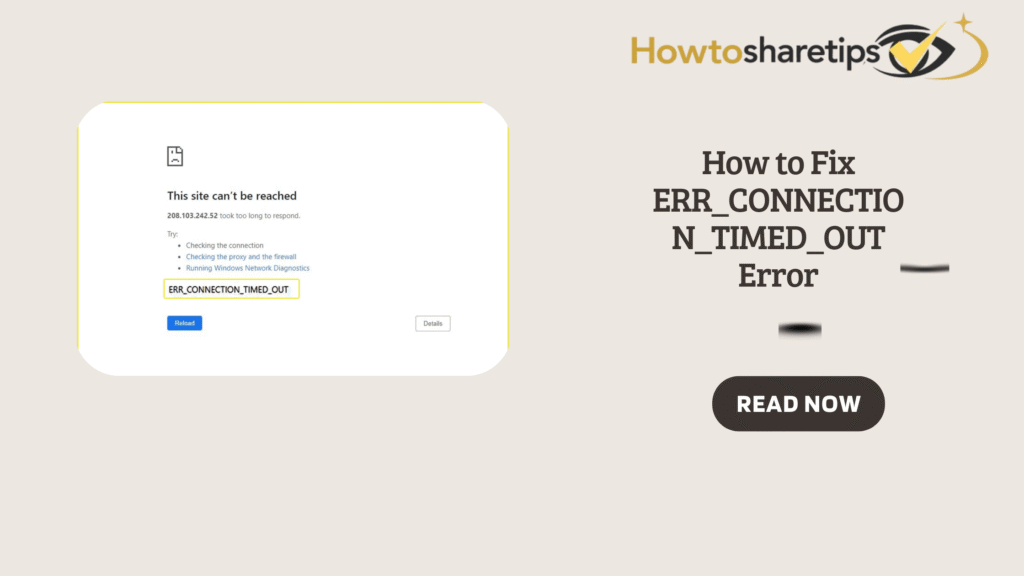The ERR_CONNECTION_TIMED_OUT error is one of the most frustrating problems internet users face. Whether you’re browsing on Google Chrome, Firefox, Microsoft Edge, or Safari, this error means your browser is struggling to connect with the website’s server. The page either takes too long to respond or fails to load completely.
The good news is, you don’t need advanced technical skills to solve it. In most cases, the issue lies in your internet connection, browser settings, or DNS configuration—and with the right steps, you can fix it in minutes.
What Causes the ERR_CONNECTION_TIMED_OUT Error?
This error happens when your browser sends a request to a website’s server but doesn’t get a response within a set time. Common causes include:
-
Slow or unstable internet connection
-
Corrupted browser cache or cookies
-
Misconfigured DNS or proxy settings
-
Firewall or antivirus blocking safe connections
-
Server-side problems from the website itself
10 Ways to Fix the ERR_CONNECTION_TIMED_OUT Error
Follow these proven fixes step by step to resolve the issue quickly:
1. Check Your Internet Connection
Start with the basics, make sure your internet is working properly. Restart your router, switch to another Wi-Fi network, or test with an Ethernet cable or mobile hotspot. A weak or unstable connection is the most common cause.
2. Restart Your Device
Glitches in your computer or smartphone can block connections. Restarting clears temporary memory and often restores proper connectivity.
3. Clear Browser Cache and Cookies
Corrupted cache files can prevent websites from loading. To fix this in Chrome:
-
Go to Settings > Privacy and Security > Clear Browsing Data
-
Select Cached images and files and Cookies
-
Restart your browser and try loading the website again
4. Flush and Renew DNS
A corrupt DNS cache may cause failed connections. To flush DNS on Windows:
-
Open Command Prompt and type:
ipconfig /flushdns -
Then type:
ipconfig /renew
This forces your device to request fresh DNS information.
5. Change DNS Servers
If flushing DNS doesn’t work, switch to a more reliable DNS provider. Popular options:
-
Google DNS: 8.8.8.8 and 8.8.4.4
-
Cloudflare DNS: 1.1.1.1 and 1.0.0.1
Changing DNS often improves speed and stability.
6. Disable Proxy Settings
Some proxy servers block websites. In Chrome:
-
Go to Settings > System > Open proxy settings
-
Ensure no unwanted proxy is enabled
7. Adjust Firewall or Antivirus Settings
Overly strict security software can mistakenly block safe websites. Temporarily disable your firewall or antivirus and check if the error resolves. If it does, add exceptions for the affected sites.
8. Reset Network Settings
When hidden conflicts remain, a full network reset may be necessary. On Windows, go to Settings > Network & Internet > Status > Network reset. On mobile, you can reset from network settings.
9. Try Another Browser or Device
Open the same website on another browser or device. If it works elsewhere, the problem lies with your browser. If it fails everywhere, the issue is likely with your ISP or the website server.
10. Check If the Website Is Down
Before spending more time troubleshooting, confirm if the site itself is offline. Use tools like DownDetector or IsItDownRightNow to check the server’s status.
When to Contact Your ISP
If none of these methods work, the problem may be with your Internet Service Provider. Contact their support team, explain the error, and ask them to run a diagnostic check.
The ERR_CONNECTION_TIMED_OUT error may seem intimidating, but it’s usually easy to fix with the right steps. From clearing your cache and updating DNS settings to checking firewalls, these proven solutions cover nearly every cause.
Always start with simple checks like testing your connection before moving to advanced fixes. And if the issue persists, remember—it could be a server-side issue that only the website owner or your ISP can resolve.
By following this guide, you’ll be able to troubleshoot and fix connection timeouts confidently, ensuring a smoother and more reliable browsing experience.



